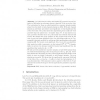302 search results - page 20 / 61 » Using Attack Injection to Discover New Vulnerabilities |
DSN
2008
IEEE
13 years 9 months ago
2008
IEEE
Software vulnerabilities are the root cause of a wide range of attacks. Existing vulnerability scanning tools are able to produce a set of suspects. However, they often suffer fro...
ACSAC
2007
IEEE
14 years 2 months ago
2007
IEEE
Understanding security bugs in a vulnerable program is a non-trivial task, even if the target program is known to be vulnerable. Though there exist debugging tools that facilitate...
HASE
2008
IEEE
14 years 2 months ago
2008
IEEE
Side channel attacks are non-invasive attacks in which adversaries gain confidential information by passively observing the target computing device. Sensor nodes are particularly...
CRYPTO
2003
Springer
14 years 1 months ago
2003
Springer
Abstract. In 1998, Boneh, Durfee and Frankel [4] presented several attacks on RSA when an adversary knows a fraction of the secret key bits. The motivation for these so-called part...
CHES
2010
Springer
13 years 9 months ago
2010
Springer
This paper introduces a new class of optical fault injection attacks called bumping attacks. These attacks are aimed at data extraction from secure embedded memory, which usually s...

